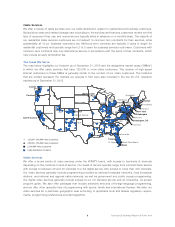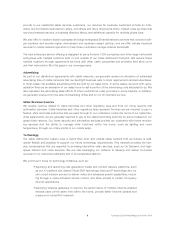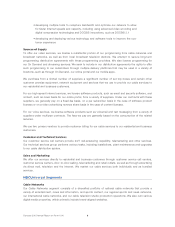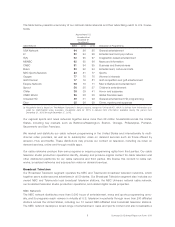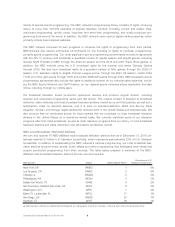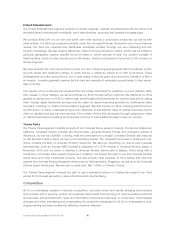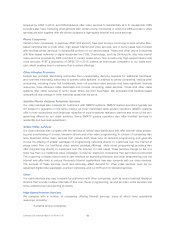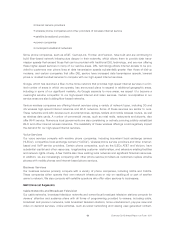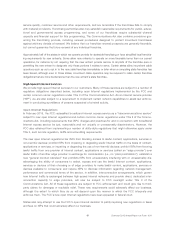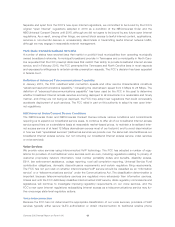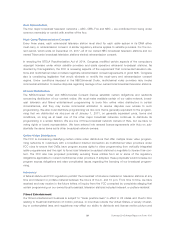Comcast 2015 Annual Report Download - page 16
Download and view the complete annual report
Please find page 16 of the 2015 Comcast annual report below. You can navigate through the pages in the report by either clicking on the pages listed below, or by using the keyword search tool below to find specific information within the annual report.• Internet service providers
• wireless phone companies and other providers of wireless Internet service
• satellite broadband providers
• power companies
• municipal broadband networks
Some phone companies, such as AT&T, CenturyLink, Frontier and Verizon, have built and are continuing to
build fiber-based network infrastructure deeper in their networks, which allows them to provide data trans-
mission speeds that exceed those that can be provided with traditional DSL technology, and are now offering
these higher-speed services in many of our service areas. DSL technology allows Internet access to be pro-
vided to customers over phone lines at data transmission speeds substantially greater than those of dial-up
modems, and certain companies that offer DSL service have increased data transmission speeds, lowered
prices or created bundled services to compete with our high-speed Internet services.
Google, which has launched a fiber-to-the-home network that provides high-speed Internet services in a lim-
ited number of areas in which we operate, has announced plans to expand in additional geographic areas,
including in some of our significant markets. As Google expands to more areas, we expect it to become a
meaningful wireline competitor to our high-speed Internet and video services. Certain municipalities in our
service areas are also building fiber-based networks.
Various wireless companies are offering Internet services using a variety of network types, including 3G and
4G wireless high-speed Internet networks and Wi-Fi networks. Some of these services are similar to ours.
These networks work with devices such as smartphones, laptops, tablets and mobile wireless routers, as well
as wireless data cards. A number of commercial venues, such as retail malls, restaurants and airports, also
offer Wi-Fi service. Numerous local governments are also considering or actively pursuing publicly subsidized
Wi-Fi and other Internet access networks. The availability of these wireless offerings could negatively impact
the demand for our high-speed Internet services.
Voice Services
Our voice services compete with wireline phone companies, including incumbent local exchange carriers
(“ILECs”), competitive local exchange carriers (“CLECs”), wireless phone service providers and other Internet-
based and VoIP service providers. Certain phone companies, such as the ILECs AT&T and Verizon, have
substantial capital and other resources, longstanding customer relationships, and extensive existing facilities
and network rights-of-way. A few CLECs also have existing local networks and significant financial resources.
In addition, we are increasingly competing with other phone service providers as customers replace wireline
phones with mobile phones and Internet-based phone services.
Business Services
Our business services primarily compete with a variety of phone companies, including ILECs and CLECs.
These companies either operate their own network infrastructure or rely on reselling all or part of another
carrier’s network. We also compete with satellite operators who offer video services to businesses.
NBCUniversal Segments
Cable Networks and Broadcast Television
Our cable networks, broadcast television networks and owned local broadcast television stations compete for
viewers’ attention and audience share with all forms of programming provided to viewers, including cable,
broadcast and premium networks, local broadcast television stations, home entertainment, pay-per-view and
video on demand services, online activities, such as social networking and viewing user-generated content,
13 Comcast 2015 Annual Report on Form 10-K


